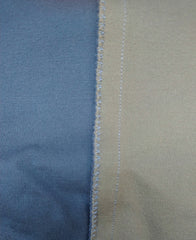Maker Inspo: Aldaia Dress in Ponte
Ponte is a bit of a strange knit. It’s thinner than fleece, but heavier than jersey. It is very stretchy, but somehow holds its structure. It has a smooth matte finish on both sides, from its tight weave.
This dress uses the best features of ponte to give shape and structure without bulk. I wanted to try colourblocking a knit, using several solid colours of fabric. While this pattern wasn’t written specifically for colourblocks, it only took a few extra steps to make it work.
The Aldaia dress by Pauline Alice Designs has several options for bodice, sleeves, and skirt. I think each style would work best in a different weight of fabric. The 6-gore skirt looks flouncy, which is best in a light jersey. The 3/4 sleeves are not fitted, so they need some structure. And the sleeveless wrap top needs to be well fitted, in a very stretchy material. For this dress, I chose to combine the shorter panelled skirt of View A with the sleeveless wrap top from View B.

Before cutting anything, I wanted to see how different colour combinations would work. A friend suggested getting out the crayons, but that seemed like a lot of work. Instead, I opened MS Paint. I copied the outline of the dress parts, and made a template. Then I copied the template and filled it with paint colours as many times as I wanted! Here are a few of the finalists, based on the Steel, Mauve, and Army colours of the Royce Ponte de Roma.

The fronts of the bodice and skirt are already in three pieces each, with separate neck and armbands, so that was an obvious place to start mixing up colours. I wanted the back to match, so I split the bodice and skirt back into similar pieces. And I added a hem band instead of a folded hem to tie the parts together.

The main lesson that I learned in converting a pattern to colourblock pieces is to use what you have first. To split the back skirt pattern into 3 pieces, I first took the front side skirt pattern piece and laid it over the back piece. Cutting out the dart and adding in seam allowances on BOTH SIDES, I cut the back piece down to just a centre-back. The bodice was a little harder, since the arm holes are not identical on the front and back. But a similar process worked, to modify the front side piece until it matched the correct shape, then cut the original bodice back piece down to be the centre back.
Then the first step in sewing the garment is to sew together the colourblocked parts, to get the original pieces from the pattern. After sewing each one together, I laid them over the original back bodice and skirt pattern pieces (with the darts folded under), to make sure they matched. One nice side effect is that I didn’t need to sew the darts; they are now built into the new seams, just like on the front.

I love that a knit like this is very forgiving, you can always stretch bits into place as you sew. I don’t have a serger, but this technique has worked well for me. First, zig-zag over the edge of each seam, no stretching. Then straight stitch on the seam line with a slight stretch. Iron the seam allowance to one side, and then topstitch through the seam allowance. The topstitching is optional, and it can make the end result a little less stretchy, but it looks very clean.
The fit of this dress is even tighter than expected. The pattern says it is “designed with negative ease for a very close fit.” I graded the hip up a couple of sizes, which I often have to do because my hips are much larger than my waist. But even so, it has several inches of negative ease all over. It still fits because of the ponte’s stretch, but it does show off my curves.


